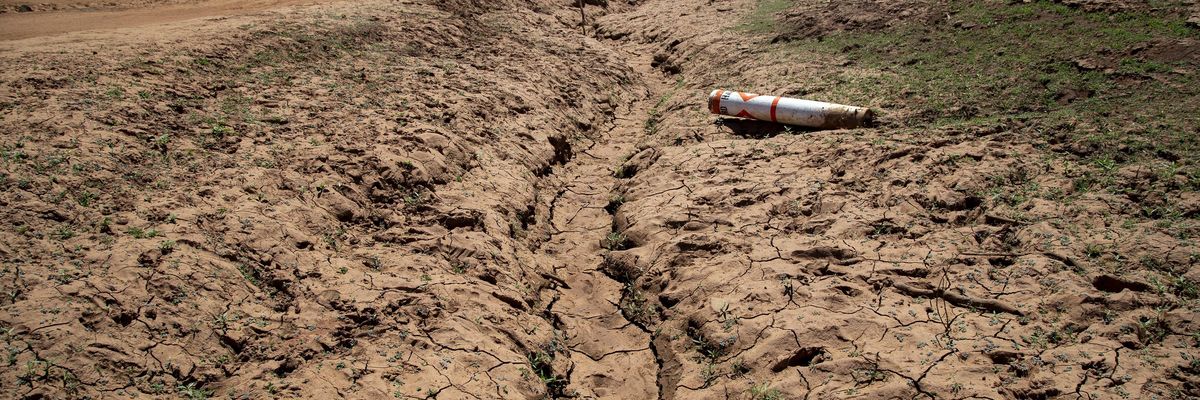
Dried mud and a stranded buoy on the lakebed at Lake Oroville, which stood at 33% full and 40% of historical average when this photograph was taken on Tuesday, June 29, 2021 in Oroville, California. (Photo: Brian van der Brug / Los Angeles Times via Getty Images)
Climate-Linked Drought Leads to First Ever Shutdown of California Hydropower Plant
"Climate change is worsening California's water crisis."
California officials blamed the climate crisis-fueled drought and earlier lack of snowmelt in announcing Thursday that, for the first time ever, historic low water levels forced the hydropower plant at Lake Oroville to be taken offline.
The development comes amid a massive drought gripping the western United States, with entire state of California experiencing some level of drought.
"This is just one of many unprecedented impacts we are experiencing in California as a result of our climate-induced drought."
Water levels at Lake Oroville, the state's second largest reservoir, have been dropping for months, prompting it to be called "the shocking face of California's drought."
The lake's depletion led to the long anticipated shutdown of the Hyatt plant--completed in 1967 and able to power up to 800,000 homes at full capacity.
The Chico Enterprise-Record reported that the lake on Tuesday hit its lowest levels since September 1977, measuring 643.5 feet above sea level--a level that threatens the plant's ability to turn turbines. "The lake level has dropped a stunning 250 feet in the past two years," noted the San Jose Mercury News.
Department of Water Resources (DWR) director Karla Nemeth announced the news Thursday in a statement urging Californians to conserve water.
"DWR State Water Project operations managers have taken the Hyatt Powerplant at Lake Oroville offline due to falling lake levels," she said. "This is the first time Hyatt Powerplant has gone offline as a result of low lake levels. However, DWR anticipated this moment, and the state has planned for its loss in both water and grid management."
"This is just one of many unprecedented impacts we are experiencing in California as a result of our climate-induced drought," Nemeth added. "California and much of the western part of the United States are experiencing the impacts of accelerated climate change including record-low reservoir levels due to dramatically reduced runoff this spring."
The state now "has to lean on other power options as it suffers the impacts of climate change," Politico reported. "While the state can import additional supply, that has become less reliable as major wildfires threaten Western transmission lines, as was the case last month in Oregon during a heat wave in California."
According to the California Energy Commission, in 2020, electric generation from nuclear, large hydroelectric, and renewables made for 51% of its in-state generation, down from to 57% in 2019. "The change is directly attributable to the significantly reduced hydroelectric generation, some 44% lower than 2019 generation levels, as dry conditions returned to the state."
Water resources expert and Pacific Institute founder Peter Gleick remarked on the milestone event in a Friday tweet.
"During the worst two-year (1976-77) five-year (2012-16), & six-year (1987-92) droughts on record," wrote Gleick, "Oroville Dam's powerplant never shut down for lack of water."
"It's shut now," he said. "Climate change is worsening California's water crisis."
An Urgent Message From Our Co-Founder
Dear Common Dreams reader, The U.S. is on a fast track to authoritarianism like nothing I've ever seen. Meanwhile, corporate news outlets are utterly capitulating to Trump, twisting their coverage to avoid drawing his ire while lining up to stuff cash in his pockets. That's why I believe that Common Dreams is doing the best and most consequential reporting that we've ever done. Our small but mighty team is a progressive reporting powerhouse, covering the news every day that the corporate media never will. Our mission has always been simple: To inform. To inspire. And to ignite change for the common good. Now here's the key piece that I want all our readers to understand: None of this would be possible without your financial support. That's not just some fundraising cliche. It's the absolute and literal truth. We don't accept corporate advertising and never will. We don't have a paywall because we don't think people should be blocked from critical news based on their ability to pay. Everything we do is funded by the donations of readers like you. Will you donate now to help power the nonprofit, independent reporting of Common Dreams? Thank you for being a vital member of our community. Together, we can keep independent journalism alive when it’s needed most. - Craig Brown, Co-founder |
California officials blamed the climate crisis-fueled drought and earlier lack of snowmelt in announcing Thursday that, for the first time ever, historic low water levels forced the hydropower plant at Lake Oroville to be taken offline.
The development comes amid a massive drought gripping the western United States, with entire state of California experiencing some level of drought.
"This is just one of many unprecedented impacts we are experiencing in California as a result of our climate-induced drought."
Water levels at Lake Oroville, the state's second largest reservoir, have been dropping for months, prompting it to be called "the shocking face of California's drought."
The lake's depletion led to the long anticipated shutdown of the Hyatt plant--completed in 1967 and able to power up to 800,000 homes at full capacity.
The Chico Enterprise-Record reported that the lake on Tuesday hit its lowest levels since September 1977, measuring 643.5 feet above sea level--a level that threatens the plant's ability to turn turbines. "The lake level has dropped a stunning 250 feet in the past two years," noted the San Jose Mercury News.
Department of Water Resources (DWR) director Karla Nemeth announced the news Thursday in a statement urging Californians to conserve water.
"DWR State Water Project operations managers have taken the Hyatt Powerplant at Lake Oroville offline due to falling lake levels," she said. "This is the first time Hyatt Powerplant has gone offline as a result of low lake levels. However, DWR anticipated this moment, and the state has planned for its loss in both water and grid management."
"This is just one of many unprecedented impacts we are experiencing in California as a result of our climate-induced drought," Nemeth added. "California and much of the western part of the United States are experiencing the impacts of accelerated climate change including record-low reservoir levels due to dramatically reduced runoff this spring."
The state now "has to lean on other power options as it suffers the impacts of climate change," Politico reported. "While the state can import additional supply, that has become less reliable as major wildfires threaten Western transmission lines, as was the case last month in Oregon during a heat wave in California."
According to the California Energy Commission, in 2020, electric generation from nuclear, large hydroelectric, and renewables made for 51% of its in-state generation, down from to 57% in 2019. "The change is directly attributable to the significantly reduced hydroelectric generation, some 44% lower than 2019 generation levels, as dry conditions returned to the state."
Water resources expert and Pacific Institute founder Peter Gleick remarked on the milestone event in a Friday tweet.
"During the worst two-year (1976-77) five-year (2012-16), & six-year (1987-92) droughts on record," wrote Gleick, "Oroville Dam's powerplant never shut down for lack of water."
"It's shut now," he said. "Climate change is worsening California's water crisis."
California officials blamed the climate crisis-fueled drought and earlier lack of snowmelt in announcing Thursday that, for the first time ever, historic low water levels forced the hydropower plant at Lake Oroville to be taken offline.
The development comes amid a massive drought gripping the western United States, with entire state of California experiencing some level of drought.
"This is just one of many unprecedented impacts we are experiencing in California as a result of our climate-induced drought."
Water levels at Lake Oroville, the state's second largest reservoir, have been dropping for months, prompting it to be called "the shocking face of California's drought."
The lake's depletion led to the long anticipated shutdown of the Hyatt plant--completed in 1967 and able to power up to 800,000 homes at full capacity.
The Chico Enterprise-Record reported that the lake on Tuesday hit its lowest levels since September 1977, measuring 643.5 feet above sea level--a level that threatens the plant's ability to turn turbines. "The lake level has dropped a stunning 250 feet in the past two years," noted the San Jose Mercury News.
Department of Water Resources (DWR) director Karla Nemeth announced the news Thursday in a statement urging Californians to conserve water.
"DWR State Water Project operations managers have taken the Hyatt Powerplant at Lake Oroville offline due to falling lake levels," she said. "This is the first time Hyatt Powerplant has gone offline as a result of low lake levels. However, DWR anticipated this moment, and the state has planned for its loss in both water and grid management."
"This is just one of many unprecedented impacts we are experiencing in California as a result of our climate-induced drought," Nemeth added. "California and much of the western part of the United States are experiencing the impacts of accelerated climate change including record-low reservoir levels due to dramatically reduced runoff this spring."
The state now "has to lean on other power options as it suffers the impacts of climate change," Politico reported. "While the state can import additional supply, that has become less reliable as major wildfires threaten Western transmission lines, as was the case last month in Oregon during a heat wave in California."
According to the California Energy Commission, in 2020, electric generation from nuclear, large hydroelectric, and renewables made for 51% of its in-state generation, down from to 57% in 2019. "The change is directly attributable to the significantly reduced hydroelectric generation, some 44% lower than 2019 generation levels, as dry conditions returned to the state."
Water resources expert and Pacific Institute founder Peter Gleick remarked on the milestone event in a Friday tweet.
"During the worst two-year (1976-77) five-year (2012-16), & six-year (1987-92) droughts on record," wrote Gleick, "Oroville Dam's powerplant never shut down for lack of water."
"It's shut now," he said. "Climate change is worsening California's water crisis."

